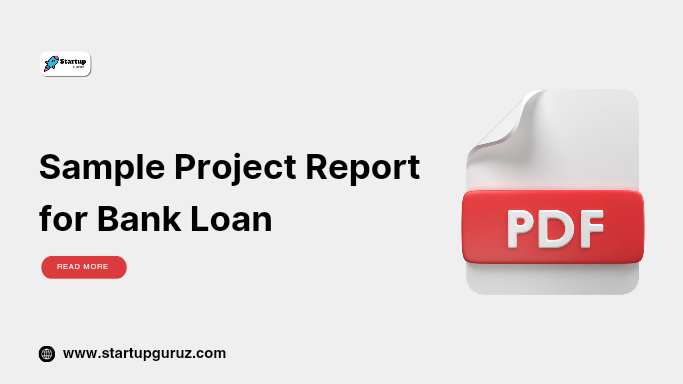Sample Project Report for Bank Loan
Sample Project Report for Bank Loan: Comprehensive Guide and Free PDF Download
Applying for a bank loan can be a daunting task, especially when you’re required to submit a project report to justify your business proposal. A project report is a detailed document that outlines the nature of your business, its objectives, financial projections, and other relevant data needed by the bank to assess your loan application. Banks and financial institutions rely heavily on these reports to evaluate the feasibility and profitability of your business venture before approving the loan. In this guide, we’ll provide a step-by-step walkthrough of creating a sample project report for a bank loan.
We will also discuss the significance of each section of the report, provide a downloadable sample project report PDF, and answer the most common questions regarding project reports for bank loans.

What is a Project Report for Bank Loan?
A project report is a formal document that provides detailed information about a business plan, including its objectives, financial status, market potential, operational plans, and expected profitability. Banks require these reports to assess the creditworthiness of the applicant and the viability of the business. The report helps the bank determine whether the business can repay the loan within the stipulated time frame.
Key Components of a Bank Loan Project Report
The project report typically includes the following components:
- Executive Summary: This section provides an overview of the business idea, including its objectives, nature of operations, and the amount of loan required.
- Business Profile: A detailed description of the business, including its history, management structure, and legal status (proprietorship, partnership, LLP, etc.).
- Market Analysis: This includes a study of the current market trends, demand for the product/service, competition, and target customer base.
- Production Plan/Service Plan: If you are producing a product, this section includes information about the production process, equipment required, and suppliers. For service businesses, it outlines the service delivery mechanism.
- Financial Projections: This is one of the most critical parts of the project report, including profit and loss statements, balance sheets, and cash flow projections for the next few years.
- Break-even Analysis: This analysis determines when the business will start generating enough revenue to cover its costs.
- SWOT Analysis: This identifies the Strengths, Weaknesses, Opportunities, and Threats associated with the business.
- Details of the Loan: This section outlines the amount of loan required, its purpose, and the proposed repayment schedule.
Why is a Project Report Important for a Bank Loan?
Banks need assurance that the money they lend will be returned, along with interest, within the specified time. A project report provides a clear picture of your business, helping the bank assess the risk and viability of your venture. Here are the key reasons why a project report is crucial for obtaining a loan:
- Risk Assessment: The bank evaluates how risky your business is by studying your financial projections, market conditions, and operational plans.
- Feasibility Study: A well-prepared project report demonstrates the feasibility and profitability of the business, ensuring the bank that you have a solid plan to generate revenue and repay the loan.
- Transparency: It offers transparency in terms of how the loan amount will be utilized, including breakdowns of equipment, inventory, marketing expenses, etc.
- Loan Sanctioning: The better your project report, the higher your chances of getting the loan sanctioned.
Steps to Create a Project Report for a Bank Loan
Below is a step-by-step guide to preparing a comprehensive project report for your bank loan application:
Step 1: Prepare an Executive Summary
The executive summary is the first section of your project report and provides a concise overview of your business. It should briefly highlight:
- Your business idea.
- The purpose of the loan.
- The amount of loan requested.
- The projected returns on investment.
While this section is short, it should be compelling enough to make the bank interested in reading the entire report.
Step 2: Write the Business Profile
In this section, describe your business in detail, including:
- The nature of the business (manufacturing, service, trading, etc.).
- The business structure (sole proprietorship, partnership, or company).
- Date of establishment.
- The experience of the promoters.
- Any licenses or registrations (like GST, MSME, etc.).
Step 3: Conduct a Market Analysis
Market analysis gives the bank a better understanding of your business environment. Include the following in this section:
- Market demand for your product or service.
- Key competitors.
- Your target audience and demographics.
- Pricing strategy.
- Potential market growth.
Step 4: Production or Service Plan
For manufacturing businesses, the production plan is crucial as it describes:
- The production process.
- Machinery and raw materials required.
- Suppliers and vendors.
- Manpower needs.
- Timeline for production.
For service businesses, focus on how services will be delivered, quality control measures, and timelines.
Step 5: Provide Financial Projections
The financial projection section is one of the most critical aspects of the report. It helps the bank assess whether your business will be able to generate enough cash flow to repay the loan. Your financial projections should include:
- Profit and Loss Statement: This outlines the expected income, costs, and profits for the business over the next few years.
- Balance Sheet: This statement provides a summary of the business’s assets, liabilities, and equity.
- Cash Flow Statement: A detailed analysis of the cash inflow and outflow for the business.
Ensure these projections are realistic and based on concrete data to increase your chances of approval.
Step 6: Conduct a Break-even Analysis
A break-even analysis tells the bank when your business will start generating enough revenue to cover its costs. This is essential for understanding how long it will take before your business becomes profitable. A good break-even analysis will help reassure the bank that you have a clear path to profitability.
Step 7: Perform a SWOT Analysis
A SWOT analysis (Strengths, Weaknesses, Opportunities, and Threats) is a strategic tool that helps in understanding your business’s internal strengths and weaknesses, as well as external opportunities and threats. This section provides banks with insights into your business’s potential risks and growth prospects.
Step 8: Include Loan Details and Repayment Plan
Finally, include detailed information about the loan, such as:
- The amount required.
- The purpose of the loan (purchase of equipment, working capital, etc.).
- Proposed tenure of the loan.
- Repayment schedule, including EMIs.
Make sure the proposed repayment schedule aligns with your business’s cash flow projections.
Download Sample Project Report for Bank Loan (PDF)
To help you get started, you can download a sample project report for a bank loan in PDF format. This sample is designed to give you a practical understanding of the content and structure required for preparing a successful project report. It includes all the essential components mentioned above and is customizable for any type of business.
10 FAQs About Project Reports for Bank Loans
1. What is the purpose of a project report for a bank loan?
A project report helps the bank assess the feasibility, profitability, and risk associated with your business venture before approving the loan.
2. What details should be included in a project report?
The report should include an executive summary, business profile, market analysis, financial projections, production/service plan, break-even analysis, and loan details.
3. Can I prepare a project report myself, or should I hire a professional?
While you can prepare the report yourself, hiring a professional accountant or consultant may increase the chances of approval by ensuring that the report is accurate and complete.
4. Do I need a project report for a small business loan?
Yes, even for small business loans, banks may require a project report to assess the viability and profitability of your business.
5. How long should a project report be?
There is no fixed length, but the report should be comprehensive and cover all key aspects of your business plan in a clear and concise manner.
6. What financial projections should be included in the project report?
Financial projections should include the profit and loss statement, balance sheet, and cash flow statement for the next 3-5 years.
7. What is a break-even analysis in a project report?
A break-even analysis calculates the point at which your business will start generating enough revenue to cover its costs, indicating when it will become profitable.
8. Can I use a template for the project report?
Yes, you can use a template or sample report as a guideline, but make sure to customize it to reflect the specific details of your business.
9. How important is the market analysis in a project report?
The market analysis is crucial as it helps the bank understand the demand for your product or service, the competition, and your market positioning.
10. What should I do if my project report is rejected by the bank?
If your project report is rejected, ask for feedback and address the concerns raised by the bank. You may need to revise your financial projections, market analysis, or repayment plan.
